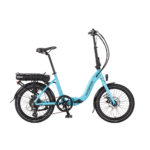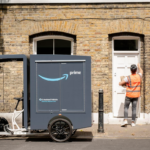Last weekend, I took my bike on the longest round trip I've ever attempted (Oxford-Kidlington and back) to see what the range was on my dodgy old Phylion battery. The location I chose is the furthest place from my home, and as far as I ever need to go on an ebike (6-7 miles each way). The supplier claimed a range of 25-29 miles. My first thread deals with the issues of the battery, and I estimated an absolute maximum range of 15 miles.
I did not have a GPS, bike computer (difficult to install on my wheels) or any other distance or speed measuring equipment. I put the exact routes I took into Google Maps and Bing Maps to determine the distance, and I found a discrepancy of a quarter mile between the websites. I used a stopwatch.
Because I had issues with the battery wiring and packs being unstuck, I was advised not to attempt the journey by many people in case of breakdown. The chain keeps coming off, and am unable to pedal too far without stopping, and I'm going to fit a tensioner soon. After I last opened the battery 2 months ago to use duct tape to secure the packs, I've had no more power loss. So I decide to go ahead.
Saturday night/Sunday morning I attempted the journey. I set off just after 1:00am. Outside temperature was 8°c but falling. Battery fully charged. Got on the bike and started the stopwatch. My lights were on the whole time.
The roads were virtually empty, so no traffic. The throttle remained fully open 95% of the time. Arrived in Kidlington 23 minutes later. As I was going over the A34, by the Water Eaton P&R a section of road was unlit. My headlamp is poor having only one beam, so having checked my mirrors seeing nothing behind, followed the cateye reflections in the road. After passing the well-lit junction, I pulled onto the bicycle path, and used a wind-up torch pointed at the road so I could see better on the remaining section of road up to the roundabout.
Had similar problems on the return journey, however I was in the bus lane, and although I couldn't see the imperfections in the road, no buses were running, and it was a bit easier. The bike easily made it past my home, and I continued further up the road until my Low light came on, and the battery failed as I was halfway down my street!
It was very interesting for me, I learnt a few things.
1: My previous experience on an unlit cycle track hadn't taught me to investigate in better headlights. Although front and rear are bright, I suspect it is pointing slightly upwards, so I can see signs, the surroundings, and everything else but the road.
2: The bike is more efficient at speed, but I sort of knew this already.
3: There seems to be something that causes traffic lights to turn green when I approach, especially in certain bus lanes but not others. I suspect the hub motor?
4: That if I attempted the journey during daylight, without the lights surely I can get an increase in range, and possibly go a bit further. And what about on a warmer day (or night?)
5: That if I ever needed to go to Kidlington, I could get there in a third of the time and so much cheaper than using a bus.
The results:
I had driven 12.5 miles in total. I was hoping for 13 miles, but I had to use lights at all times, and the temperature was under 7°C when I returned.
Stopwatch indicated just over 58 minutes for the entire journey. I got asked for directions, and had also wasted time trying to negotiate an unlit part of the route, so about 5 minutes total lost.
Power loss on the battery was minimal. The throttle eventually gave less and less power in the last half mile. Turning the key off and on restored power, but I found you can only get full power (what was left anyway) through pedelec. Throttle didn't really work. Eventually power stops, but flicking the key off and on reset it again. I did this about 5 times until the final cutout (alarm goes off and all lights then die) which occured on my street. It is reassuring to know that once the throttle stops responding, I can squeeze the last bit of power out by using the pedals and resetting the key, but why wouldn't the throttle allow me to access the last bit of power?
The final test was the battery voltage. I got my multimeter out and took some readings. Of course the battery had time to rest from the journey, and also after charging.
The battery has a separate charging socket, as well as the kettle socket that goes to the bike. I measured both these when full and discharged. There is a discrepancy I need help with:
Phylion XH370-10J 37.0VDC.
Fully charged at load socket 41.8VDC (usually reads 42.0V but my meter was cold)
Fully charged at charge socket 41.2VDC
Fully discharged at load socket 26.5VDC (does this seem low to you for a 36V battery?)
Fully discharged at charge socket 34.5VDC (seems a bit more right to me!)
The only thing I can think of this time of the night is that the BMS low volt protection has shut off the load socket, but not fully, which seems weird. If possible, I would like to see charge/discharged voltages of other peoples 36V lithium polymer and see if there is a huge discrepancy between the two sockets, and if so, why?
Thank you for reading!
I did not have a GPS, bike computer (difficult to install on my wheels) or any other distance or speed measuring equipment. I put the exact routes I took into Google Maps and Bing Maps to determine the distance, and I found a discrepancy of a quarter mile between the websites. I used a stopwatch.
Because I had issues with the battery wiring and packs being unstuck, I was advised not to attempt the journey by many people in case of breakdown. The chain keeps coming off, and am unable to pedal too far without stopping, and I'm going to fit a tensioner soon. After I last opened the battery 2 months ago to use duct tape to secure the packs, I've had no more power loss. So I decide to go ahead.
Saturday night/Sunday morning I attempted the journey. I set off just after 1:00am. Outside temperature was 8°c but falling. Battery fully charged. Got on the bike and started the stopwatch. My lights were on the whole time.
The roads were virtually empty, so no traffic. The throttle remained fully open 95% of the time. Arrived in Kidlington 23 minutes later. As I was going over the A34, by the Water Eaton P&R a section of road was unlit. My headlamp is poor having only one beam, so having checked my mirrors seeing nothing behind, followed the cateye reflections in the road. After passing the well-lit junction, I pulled onto the bicycle path, and used a wind-up torch pointed at the road so I could see better on the remaining section of road up to the roundabout.
Had similar problems on the return journey, however I was in the bus lane, and although I couldn't see the imperfections in the road, no buses were running, and it was a bit easier. The bike easily made it past my home, and I continued further up the road until my Low light came on, and the battery failed as I was halfway down my street!
It was very interesting for me, I learnt a few things.
1: My previous experience on an unlit cycle track hadn't taught me to investigate in better headlights. Although front and rear are bright, I suspect it is pointing slightly upwards, so I can see signs, the surroundings, and everything else but the road.
2: The bike is more efficient at speed, but I sort of knew this already.
3: There seems to be something that causes traffic lights to turn green when I approach, especially in certain bus lanes but not others. I suspect the hub motor?
4: That if I attempted the journey during daylight, without the lights surely I can get an increase in range, and possibly go a bit further. And what about on a warmer day (or night?)
5: That if I ever needed to go to Kidlington, I could get there in a third of the time and so much cheaper than using a bus.
The results:
I had driven 12.5 miles in total. I was hoping for 13 miles, but I had to use lights at all times, and the temperature was under 7°C when I returned.
Stopwatch indicated just over 58 minutes for the entire journey. I got asked for directions, and had also wasted time trying to negotiate an unlit part of the route, so about 5 minutes total lost.
Power loss on the battery was minimal. The throttle eventually gave less and less power in the last half mile. Turning the key off and on restored power, but I found you can only get full power (what was left anyway) through pedelec. Throttle didn't really work. Eventually power stops, but flicking the key off and on reset it again. I did this about 5 times until the final cutout (alarm goes off and all lights then die) which occured on my street. It is reassuring to know that once the throttle stops responding, I can squeeze the last bit of power out by using the pedals and resetting the key, but why wouldn't the throttle allow me to access the last bit of power?
The final test was the battery voltage. I got my multimeter out and took some readings. Of course the battery had time to rest from the journey, and also after charging.
The battery has a separate charging socket, as well as the kettle socket that goes to the bike. I measured both these when full and discharged. There is a discrepancy I need help with:
Phylion XH370-10J 37.0VDC.
Fully charged at load socket 41.8VDC (usually reads 42.0V but my meter was cold)
Fully charged at charge socket 41.2VDC
Fully discharged at load socket 26.5VDC (does this seem low to you for a 36V battery?)
Fully discharged at charge socket 34.5VDC (seems a bit more right to me!)
The only thing I can think of this time of the night is that the BMS low volt protection has shut off the load socket, but not fully, which seems weird. If possible, I would like to see charge/discharged voltages of other peoples 36V lithium polymer and see if there is a huge discrepancy between the two sockets, and if so, why?
Thank you for reading!
Last edited:






